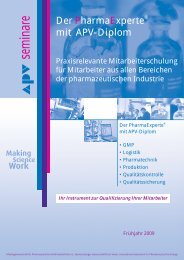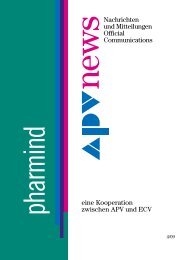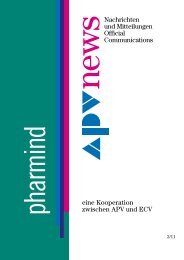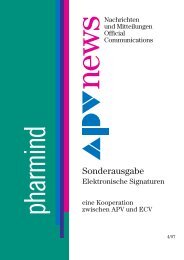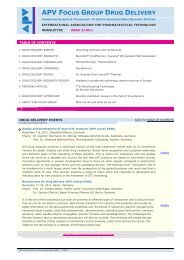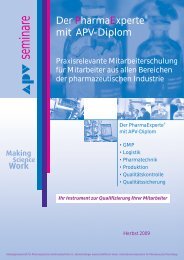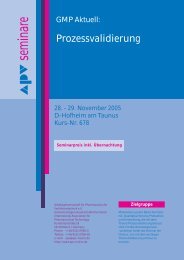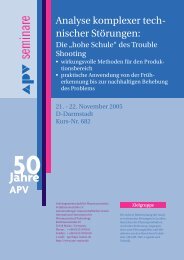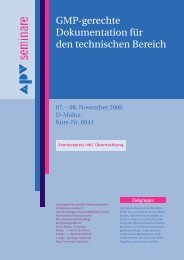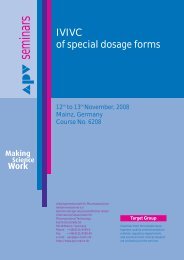APV FOCUS GROUP DRUG DELIVERY
APV FOCUS GROUP DRUG DELIVERY
APV FOCUS GROUP DRUG DELIVERY
You also want an ePaper? Increase the reach of your titles
YUMPU automatically turns print PDFs into web optimized ePapers that Google loves.
TABLE OF CONTENTS<br />
<strong>APV</strong> <strong>FOCUS</strong> <strong>GROUP</strong> <strong>DRUG</strong> <strong>DELIVERY</strong><br />
COMBINING SCIENCE & TECHNOLOGY TO CREATE ADVANCED <strong>DRUG</strong> <strong>DELIVERY</strong> SYSTEMS<br />
INTERNATIONAL ASSOCIATION FOR PHARMACEUTICAL TECHNOLOGY<br />
NEWSLETTER ISSUE 1/2011<br />
| <strong>APV</strong> Home | Focus Group Home | Contact us | Unsubscribe | Disclaimer |<br />
◊ <strong>DRUG</strong> <strong>DELIVERY</strong> EVENTS: Upcoming seminars and conferences<br />
◊ <strong>APV</strong> COURSE SUMMARY: Transdermal Drug Delivery Systems - The Essentials of Industrial Development<br />
◊ <strong>DRUG</strong> <strong>DELIVERY</strong> PRODUCTS: Abstral ® sublingual tablets / Xeplion ®<br />
◊ <strong>DRUG</strong> <strong>DELIVERY</strong> COMPANIES:<br />
BIOCYDEX SAS (Poitiers, France)<br />
◊ <strong>DRUG</strong> <strong>DELIVERY</strong> TERMINOLOGY: Biopharmaceutical (noun) / Biopharmaceutical (adjective)<br />
◊ <strong>DRUG</strong> <strong>DELIVERY</strong> PEOPLE: Kazunori Kataoka, The University of Tokyo, Japan.<br />
◊ FEATURED ARTICLE: Drug Delivery Systems Used To Deliver Opioids in Chronic Pain Therapy - Part I<br />
By Johannes Bartholomäus<br />
◊ <strong>DRUG</strong> <strong>DELIVERY</strong> LITERATURE: Recently published reviews in the field of drug delivery<br />
◊ ABOUT OUR <strong>FOCUS</strong> <strong>GROUP</strong>: Who are we and what do we do?<br />
<strong>DRUG</strong> <strong>DELIVERY</strong> EVENTS BACK TO TABLE OF CONTENTS<br />
Provided by Christoph Blümer<br />
◊ <strong>APV</strong> course: Skin Forum 12th Annual Meeting<br />
Penetrating the Stratum Corneum - Measurement, Modulation and Modelling<br />
March 28 th - 29 th 2011, Westend Campus, Goethe University Frankfurt, Germany<br />
Drug Delivery and Formulation America 2011<br />
April 27 th - 28 th 2011, La Jolla, San Diego, USA<br />
Suggest a meeting to be announced!<br />
Details<br />
Details<br />
<strong>APV</strong> COURSE SUMMARY BACK TO TABLE OF CONTENTS<br />
Provided by Dr. Stefan Bracht<br />
Transdermal Drug Delivery Systems - The Essentials of Industrial Development<br />
Miesbach, Germany 28 th - 29 th Oct 2010<br />
The course “Transdermal Drug Delivery Systems - The Essentials of Industrial Development” was first held by the <strong>APV</strong> in<br />
2004 and was very successful. The second edition of this event in October 2010 gave everybody the interesting opportunity<br />
to review 6 years’ progress in transdermal drug delivery. During this period exciting new drugs like Rivastigmin or<br />
Rotigotine and others have entered the market and a very high number of generic fentanyl patches have been launched.<br />
Regulatory authorities have both widened and deepened their understanding of transdermal dosage forms and this is<br />
exemplified by the fact that today patch performance in terms of area needed to deliver the drug may be viewed as an<br />
important quality criterion. An inefficient formulation that requires a much larger patch size or delivers only a small fraction<br />
of the drug payload compared to the originator or generic competitor may even be considered non approvable in the future.<br />
The course also looked at potential future developments including innovative technologies. While transdermals may still<br />
offer many interesting commercial opportunities, it is to be expected that the age of high volume transdermal products<br />
will be gradually superseded by sophisticated small volume or niche products which address to a greater extent the<br />
specific medical needs of patients and doctors and, thus, present unique and still attractive business cases. Micro<br />
needles appear to be the most active field of ongoing technical innovation that promises to deliver commercial products<br />
in the next few years.<br />
The audience had also changed compared to 2004: Fewer drug delivery formulators attended and there were more<br />
attendees from e.g. pharmaceutical consultancy companies. The entire course was deemed a success, and may be<br />
re-run in another couple of years to follow-up on developments in this interesting market.<br />
<strong>APV</strong> Drug Delivery Focus Group Newsletter – 1/2011 Page 1 of 10
<strong>DRUG</strong> <strong>DELIVERY</strong> PRODUCTS BACK TO TABLE OF CONTENTS<br />
Provided by Dr. Louise Rosenmayr-Templeton<br />
Abstral ® (fentanyl) sublingual tablets CII (ProStrakn)<br />
On 7 January the FDA approved Abstral® tablets, ProStrakan’s sublingual fentanyl citrate formulation, for the management<br />
of breakthrough pain in cancer patients, 18 years of age and older, who are already receiving and who are tolerant<br />
to opioid therapy for their underlying persistent cancer pain [1]. The tablets, which are available in various strengths,<br />
(100 mcg, 200 mcg, 300 mcg, 400 mcg, 600 mcg and 800 mcg) were developed by ProStrakan’s partner Orexo AB of<br />
Sweden [2].<br />
Approval was based on the results of a placebo-controlled double-blind cross-over efficacy study and an open-label<br />
safety study involving opioid tolerant adult patients experiencing breakthrough cancer pain. All patients were previously<br />
stabilized on either long-acting oral opioids or transdermal fentanyl for their persistent cancer pain. In both studies patients<br />
were first titrated to identify the dose that achieved adequate analgesia without significant side-effects. In the<br />
double-blind efficacy study patients, for whom a successful dose could be identified, were randomized to a sequence of<br />
10 treatments; seven with ABSTRAL and three with placebo. The results showed that treatment with Abstral resulted in a<br />
mean sum of pain intensity difference at 30 minutes (SPID30) that was statistically significantly higher than that obtained<br />
with placebo [1].<br />
Abstral is already marketed in the UK, Germany, France, Spain, Italy and Sweden and achieved sales of £14.1m in the<br />
first ten months of 2010. Its launch on to the US market for fast-acting fentanyl products (estimated to be worth $550<br />
million annually) is planned for Q1 2011) [2].<br />
Xeplion ® (Janssen-Cilag International)<br />
On 16 December 2010 the Committee for Medicinal Products for Human Use (CHMP) [3] recommended that marketing<br />
authorisation be granted for Xeplion, 25, 50, 75, 100 and 150 mg, prolonged release suspension for injection. This product<br />
contains paliperidone palmitate, a pro-drug of the anti-psychotic, paliperidone, which itself is an active metabolite of<br />
risperidone, a drug that has been used for the treatment of schizophrenia for almost two decades. The product is indicated<br />
for the maintenance treatment of schizophrenia in adult patients stabilised with paliperidone or risperidone. However,<br />
patients who have previously been shown to be responsive to oral paliperidone or risperidone, may be administered<br />
Xeplion without prior stabilization, provided psychotic symptoms are mild to moderate and a long-acting injectable<br />
treatment is needed. The product is already marketed in the USA under the trade name Invega® Sustenna® [4].<br />
Paliperidone palmitate is a poorly water-soluble fatty acid derivative of the active which, when injected intramuscularly,<br />
dissolves slowly before being hydrolysed to palperidone and entering the systemic circulation. In order to increase the<br />
rate of dissolution and enable the formulation of a suspension for once-monthly administration, the drug is milled using<br />
Elan Drug Technologies' proprietary NanoCrystal® technology [5]. The formulation will provide schizophrenic patients<br />
and physicians with additional choice and may act to limit loss of sales when paliperidone loses patent protection in 2012<br />
[6].<br />
References and Further Information<br />
[1] Entry for Abstral on Drugs@FDA http://www.fda.gov/Drugs/default.htm<br />
Accessed on 30.1.2011<br />
[2] FDA Approval for Abstral (Fentanyl) Sublingual Tablets - US launch planned for Q1 2011. Press Release on<br />
Orexo AB’s website.<br />
http://www.orexo.com/en/Investor-Relations/Press-releases/?guid=536217<br />
Accessed on 30.1.2011<br />
[3] Committee for medicinal products for human use (CHMP) Summary of Opinion on Xeplion<br />
http://www.ema.europa.eu/docs/en_GB/document_library/Summary_of_opinion_-<br />
_Initial_authorisation/human/002105/WC500099946.pdf<br />
Accessed on 30.1.2011<br />
[4] Entry for Invega Sustennal on Drugs@FDA<br />
http://www.fda.gov/Drugs/default.htm<br />
Accessed on 30.1.2011<br />
[5] FDA Approves INVEGA® SUSTENNA for the Acute and Maintenance Treatment of Schizophrenia. Press Release<br />
on the Janssen website<br />
http://www.janssen.com/news_release.html-item-073109_1<br />
Accessed on 30.1.2011<br />
[6] Saphris and Invega Sustenna hoping to create a difference in the market. Source: EP Vantage<br />
http://www.evaluatepharma.com/Universal/View.aspx?type=Story&id=191776§ionID=&isEPVantage=yes<br />
<strong>APV</strong> Drug Delivery Focus Group Newsletter – 1/2011 Page 2 of 10
<strong>DRUG</strong> <strong>DELIVERY</strong> COMPANIES BACK TO TABLE OF CONTENTS<br />
Provided by Jeffry Grunkemeyer<br />
BIOCYDEX SAS (Poitiers, France)<br />
The technologies developed by Biocydex improve the solubility, stability and the bioavailability of synthetic and biologically<br />
(peptides, proteins) active compounds from both the health and bioengineering (diagnostics, analytical) fields. Due<br />
to a new generation of modified cyclodextrins, Biocydex has subsequently become a key player in the domain of formulation<br />
and vectorisation of active compounds of high added value for the pharmaceutical industry.<br />
Fact sheet:<br />
Founded: December 27, 2002<br />
Location: Poitiers, France<br />
Employees: 6-8<br />
Key technology: Vectipharm®<br />
The association of a vector with a cyclodextrin, combining the ability of the latter to complex and<br />
solubilise with the biospecificity of the vector<br />
Development<br />
status:<br />
Solvamax®<br />
Enhances the solubility of active principles in the pharmaceutical domain, such as oncology and<br />
ophthalmology, as well as in the molecular diagnostics field, including microbiology and fluorometry<br />
Proteosol®<br />
Significantly increases the solubility and stability of peptides and proteins, such as enzymes, of<br />
analytical and pharmaceutical interest<br />
57-LT: Solvamax, prostaglandin/glaucoma, preclinical/Phase I<br />
XD160-TX: Solvamax, docetaxel/cancer, early preclinical<br />
70-SD: Solvamax, silver sulfadiazine/anti-infective, early preclinical<br />
56-SC: Protesol, Organ, tissue & cell preservation solutions, early clinical<br />
N0-CC: Solvamax, Nutraceuticals, market<br />
N0-AO: Solvamax, Nutraceuticals, trials and characterization<br />
Partnerships: CNRS: French National Centre for Scientific Research<br />
CEA: French Atomic Energy Commission<br />
INSERM: French National Institute of Health and Medical Research<br />
INRA: French National Institute for Agricultural Research<br />
University of Poitiers<br />
CHU de Poitiers: University Hospital Centre of Poitiers<br />
Website: http://www.biocydex.net<br />
Contact: Dr. El Mustapha Belgsir, President<br />
40, avenue du Recteur Pineau<br />
F-86022 Poitiers Cedex, France<br />
Phone: +33 (5) 49 45 36 40 / +33 (5) 49 45 48 81<br />
Fax: +33 (5) 49 47 08 76<br />
E-mail: mbelgsir@biocydex.com<br />
<strong>DRUG</strong> <strong>DELIVERY</strong> TERMINOLOGY BACK TO TABLE OF CONTENTS<br />
Provided by Dr. Karsten Cremer<br />
BIOPHARMACEUTICAL (NOUN)<br />
A pharmaceutical product which is produced in full or in part by biotechnological means.<br />
Write a comment on this definition<br />
The scope of the term "biopharmaceutical" (also referred to as biopharmaceutic) has changed substantially over the past<br />
three decades. In the 1980s, it was predominantly used to designate products based on therapeutic proteins prepared<br />
by recombinant DNA technology, thus including e.g. recombinant human insulin but not pig-derived insulin. Later, the<br />
scope was expanded to include nucleic acid-based products such as aptamers and antisense oligonucleotides. It is noted<br />
<strong>APV</strong> Drug Delivery Focus Group Newsletter – 1/2011 Page 3 of 10
that the term "biologic" is increasingly used as a synonym for "biopharmaceutical". However, we should be aware that<br />
the terms have different regulatory meanings: The FDA understands biologics as biologically (rather than biotechnologically)<br />
derived products such as blood, blood components, allergenics, cellular products, tissue products, vaccines, and<br />
gene therapies, which are approved by the Center for Biologics Evaluation and Research (CBER), and not by the Center<br />
for Drug Evaluation and Research (CDER) which is responsible for the approval of pharmaceutical products including<br />
small molecules and biopharmaceuticals.<br />
BIOPHARMACEUTICAL (ADJECTIVE)<br />
1. Relating to biopharmaceuticals.<br />
2. Relating to biopharmaceutics (a pharmaceutical discipline).<br />
Write a comment on this definition<br />
Relating to biopharmaceuticals, the adjective is used to describe biopharmaceutical products, companies developing<br />
such products, the respective field of research or sector of the industry. When used in the context of biopharmaceutics<br />
(also referred to as biopharmacy) as a discipline, it relates to certain properties of drugs or drug formulations combining<br />
pharmaceutical and pharmacokinetic aspects. For example, in the well-known "Biopharmaceutical Classification System"<br />
(BCS), the adjective is used in this manner.<br />
Suggest a term to be defined Suggest a definition<br />
<strong>DRUG</strong> <strong>DELIVERY</strong> PEOPLE BACK TO TABLE OF CONTENTS<br />
Provided by Prof. Dr. Karsten Mäder<br />
KAZUNORI KATAOKA is Professor of Biomaterials at the Graduate School of<br />
Engineering of The University of Tokyo, Japan. Since 2004, he has been<br />
Professor at the Graduate School of Medicine, The University of Tokyo and<br />
Chair of the Division of Clinical Biotechnology at the Center for Disease<br />
Biology and Integrative Medicine. He also serves as Director of the Center for<br />
NanoBio Integration at the University of Tokyo, an interdisciplinary initiative<br />
sponsored by the Ministry of Education, Culture, Sports, Science and<br />
Technology (MEXT), Japan.<br />
He received his B.Eng. (1974) in Organic Chemistry, his M.Eng. (1976) and<br />
Ph.D. (1979) in Polymer Chemistry from the University of Tokyo. He held<br />
positions at the Institute of Biomedical Engineering, Tokyo Women’s Medical<br />
College (1979-1989) and the Department of Materials Engineering, Tokyo<br />
University of Science (1989-1998) before joining the faculty of the University<br />
of Tokyo in 1998.<br />
Kazunori Kataoka was a Visiting Professor at the University of Paris XIII,<br />
France (1992 and 1996), Tohoku University, Sendai, Japan (2007), and<br />
Ludwig Maximilians University, Munich, Germany (2008). He served as the<br />
Adjunct Director of the Biomaterials Center at the National Institute for Materials<br />
Science (NIMS), Japan from 2001-2004. Kataoka is past president of the Japanese Society for Biomaterials<br />
(2004-2006), President of the Japanese Society of Gene Design and Delivery (since 2004), Vice President of the Society<br />
of Polymer Science, Japan (since 2008), Fellow of the American Institute of Medical and Biological Engineering (AIMBE)<br />
(since 1999) and Fellow of Biomaterials Science and Engineering (FBSE) (since 2004).<br />
He received several awards, including an award from the Japanese Society for Biomaterials (1993), the Outstanding<br />
Paper Award from the Controlled Release Society (1995), an award from the Society of Polymer Science, Japan (2000),<br />
the Clemson Award in Basic Research from the Society for Biomaterials, USA (2005), the Barré Award from the<br />
University of Montreal (2006), the Founder’s Award from the Controlled Release Society (2008) and the National<br />
Institute of Materials Science Award, Japan (2009). He has more than 400 publications and is on the editorial board of<br />
12 international journals. He is Editor of the Journal of Biomaterials Science, Polymer Edition and Associate Editor of<br />
Biomacromolecules (American Chemical Society).<br />
Kazunori Kataoka’s name is synonymous with the development of polymeric micelles. His major research interests<br />
include supramolecular materials for nano biotechnology, focusing on gene and drug delivery.<br />
<strong>APV</strong> Drug Delivery Focus Group Newsletter – 1/2011 Page 4 of 10
FEATURED ARTICLE BACK TO TABLE OF CONTENTS<br />
<strong>DRUG</strong> <strong>DELIVERY</strong> SYSTEMS USED TO DELIVER OPIOIDS IN CHRONIC PAIN THERAPY - PART I<br />
By Johannes Bartholomäus, Ph.D., Burghöhenweg 5, 52080 Aachen<br />
1. Introduction<br />
To achieve adequate drug therapy for an individual patient not only the proper drug substance but also the drug formulation<br />
that fits best to the patient’s needs and situation should be available. The formulation has particular importance in<br />
the treatment of chronic suffering when demands like longer time of action or less frequent administration, reduction of<br />
side effects, more individualized treatment and/or just more convenience in drug application need to be taken into account.<br />
In best case, the selected formulation or drug delivery system should improve patient compliance.<br />
From the pharmaceutical industry’s perspective, there are big opportunities to create new products that meet patients’<br />
needs by improving formulations, either with proprietary compounds as part of lifecycle management or with wellestablished<br />
compounds whose use may even be extended to new indications. Some of these developments have resulted<br />
in extremely successful products which really match patients’, health care professionals and/or carers’ requirements.<br />
Others have been less commercially successful e.g. when customers are disappointed or gain no advantage from<br />
the new formulation. Other attempts to improve drug delivery cease during development, perhaps because of technical<br />
challenges, failure to show the intended efficacy or because no commercial partner can be found to market the product.<br />
The latter often happens to projects started by drug delivery companies who don’t have their own sales organization.<br />
Examples of the points raised above can be illustrated by some typical drug delivery systems used to develop opioidcontaining<br />
products for the treatment of chronic pain.<br />
Short history of opioids<br />
The opium poppy (Papaver Somniferum) and opium, the dried latex obtained after cutting the ripening poppy pods,<br />
have been known since ancient times. Pain relief by opium was already known e.g. in Egypt, Sumeria, Assyria and India<br />
before 3000 B.C. The use of opium was described in the Papyrus Ebers (1500 B.C) and later by Hippocrates and Galen.<br />
The number of extraction methods for the active principles of opium evolved over the Middle Ages from Avicenna to<br />
Paracelsus and Sydenham, and opium tincture finally found entry into pharmacopeias.<br />
1806 Sertürner isolated morphine, the main analgesic compound, from opium. Many semisynthetic and synthetic derivatives<br />
as well as analogues were introduced over the next 200 years to modify the specificity of action and/or reduce<br />
side-effects or unintended action or to increase the potency or extend the duration of action. As all those compounds<br />
bind to opioid receptors in the human body they are called “opioids.” Natural opioids are e.g. morphine, codeine and<br />
thebaine (but not papaverine and noscapine) and semisynthetic opioids include buprenorphine, dihydrocodeine, heroin,<br />
hydrocodone, hydromorphone, oxycodone, and oxymorphone. Examples of fully synthetic opioids are fentanyl, methadone,<br />
pethidine, sufentanyl, tilidine, tramadol and tapentadol. Most opioids are subject to narcotic laws because of their<br />
abuse potential due to the euphoric effects experienced at higher doses. Moreover, opioids always have been associated<br />
with a risk of addiction that may culminate in an opiophobic environment for pain therapy. Modern opioid therapy has<br />
shown that this risk is reasonably low for patients when therapeutic needs for analgesia and opioid doses are well balanced<br />
and the therapy does not last longer than indicated. The worldwide general acceptance of opioids in modern pain<br />
therapy found its expression in the so called WHO pain relief ladder originally introduced for cancer pain but now in the<br />
main accepted in benign pain, too. The ladder starts with non-opioid analgesics and adjuvants with the second step<br />
being the addition of mild opioids (e.g. tramadol, codeine, dihydrocodeine, tilidine/naloxone). The third step involves<br />
replacing the mild opioid with a strong opioid (morphine, oxycodone, oxymorphone, tapentadol, fentanyl, buprenorphine).<br />
Thus, there is generally no reason to exclude a pain patient from opioid analgesia when inclusion criteria are<br />
fulfilled and quality of life may be improved. One part of that therapy is to provide the patient with drug formulations<br />
that meet his needs for pain-relief with minimal side-effects and maximal convenience.<br />
Early formulations<br />
As practically all opioids are soluble in water early formulations were oral solutions that also allowed for individual dose<br />
adjustments. Also powders were used early on. With progress in formulation, manufacturing and medical device technologies<br />
other formulations like suppositories, tablets, capsules and solutions for injection entered the arena. In the field<br />
of abuse, alternative ways of pulmonary or nasal application e.g. smoking (opium pipes) or snorting of powders have<br />
been known for a long time.<br />
<strong>APV</strong> Drug Delivery Focus Group Newsletter – 1/2011 Page 5 of 10
2. Oral prolonged release formulations<br />
Technical solutions by drug delivery systems<br />
Modern analgesic therapy of chronic pain according to the WHO ladder requires “dosing by the clock” instead of “dosing<br />
on demand” after re-occurrence of pain. However, morphine has a relatively short plasma half-life (1.7 – 4.5 hours)<br />
and, thus, needs to be administered at a high dosing frequency of 4 – 6 administrations per day to achieve the desired<br />
therapy. A fully compliant dose administration is therefore quite a challenge for a patient, nurses or other carers. The<br />
same applies to nearly all other opioids since most also have a short elimination half-life, or a highly variable one e.g.<br />
methadone (typically 15 – 60 hours, individual values ranging from 4 – 190 hours). Hence, there was a need for prolonged<br />
release (PR) formulations that enable twice daily dosing at a maximum. Moreover, different dose strengths are<br />
needed to cope with different intensities of pain and dose escalation with increases in pain intensity and/or the development<br />
of tolerance to opioids. Also, initiating treatment with low doses is advisable in opioid naïve patients to reduce<br />
side effects like nausea, vomiting and respiratory depression. The breakthrough product to fulfill all of those therapeutic<br />
requirements was MS Contin ® / MST Retard (Napp / Mundipharma/ Purdue Pharma). In this product morphine sulfate is<br />
incorporated into a hydrophobic prolonged release matrix composed of cetostearyl alcohol and hydroxyethylcellulose<br />
(HEC). A pure cetostearyl alcohol matrix would have led to a too slow dissolution profile exceeding the target of release<br />
within 12 hours. The adjustment of the release profile was achieved by the incorporation of homogeneously dispersed<br />
HEC that swells upon contact with water, opens up the matrix slowly over hours from the surface to the center of the<br />
tablet and allows the morphine after dissolution in the ingressed water to diffuse out of the matrix. The dissolution profiles<br />
for prolonged release tablets containing 10 – 200 mg morphine sulfate pentahydrate are presented in Fig. 1. The 10<br />
– 60 mg tablets release exhibit virtually the same dissolution profile with release within about 8 hours whereas the<br />
higher doses of 100 mg and 200 mg are released more slowly.<br />
Figure 1: In-vitro dissolution profiles of MST mundipharma ®<br />
The success of the mixed matrix of hydrophobic fatty alcohols and hydrophilic water swellable polymers meant that the<br />
same formulation approach was later applied to other opioid drugs such as dihydrocodeine (DHC with cetostearyl alcohol<br />
and HEC), tramadol (Tramundin ® with cetostearyl alcohol and ethylcellulose) and in particular oxycodone (Oxycontin ® /<br />
Oxygesic ® with stearyl alcohol and Poly[ethylacrylate-co-methylmethacrylate-co-(2-trimethylammonio-ethyl) methacrylate<br />
chloride]).<br />
A purely hydrophilic matrix based on hydroxypropylmethylcellulose (HPMC) for the prolonged release of tramadol was<br />
developed by Grünenthal (Tramal ® / Contramal ® / Adolonta ® long, Topalgic ® LP). In contact with an aqueous environment<br />
the HPMC gels immediately at the surface of the tablet and allows water to progress only slowly over hours to the<br />
center of the tablet. The tramadol is thereby slowly dissolved and diffuses out of the matrix. The release from the matrix<br />
is independent from pH in the physiological range, mechanical stress, surfactants and food. All doses exhibit identical invitro<br />
dissolution profiles (Fig. 2) enabling dose proportional blood levels to be achieved when titrating the dose.<br />
<strong>APV</strong> Drug Delivery Focus Group Newsletter – 1/2011 Page 6 of 10
Figure 2: In-vitro dissolution profiles of Tramal long ®<br />
A HPMC based matrix also serves as the release control for tapentadol PR tablets which were developed and are mar-<br />
keted by Grünenthal (Palexia ® ) in different dose strengths. A further hydrophilic matrix PR formulation made of xanthan<br />
and locust bean gum (TimeRx ® ) was developed and introduced to the US market by Endo / Penwest for oxmorphone in<br />
different dose strengths (Opana ® ER).<br />
A third type of single unit PR formulation was introduced recently with hydromorphone in an osmotic delivery system<br />
(OROS ® Push-Pull ® ). This product was developed by ALZA and is marketed by Janssen-Cilag (Europe, Jurnista ® ) and<br />
Covidien (US, Exalgo ® ). The drug substance is included together with osmotically active soluble compounds in a first<br />
water soluble / swellable layer (pull layer) of a bilayer tablet whose second layer consists of a water swellable osmoti-<br />
cally active expansion layer of polyethylene oxide and sodium chloride (push layer). The whole tablet is surrounded by a<br />
semipermeable membrane that allows water to penetrate into the tablet’s core. The water causes the push layer to swell<br />
and turns the pull layer into a gel-like drug suspension / solution that is expelled through a laser drilled hole at a constant<br />
rate over time, thus, allowing for once a day dosing.<br />
A final example of monolithic PR tablets based on classical formulation principles is Ultram ® ER, developed by Biovail<br />
(now Valeant) and marketed by OrthoMcNeil. In this product the tramadol immediate release tablet core is surrounded<br />
by an ethylcellulose based diffusion layer controlling the release over more than 16 hours, hence, enabling once a day<br />
dosing.<br />
Multiparticulate formulations have also been used to produce oral PR opioid formulations and represent a different technical<br />
approach to monolith tablets. For example, oral opioid PR formulations containing pellets (beadlets) have been<br />
introduced e.g. for morphine (e.g. Capros ® , M-long ® , Morphelan ® , Avinza ® ) or tramadol (e.g. Tramadolor ® ). A lot of the<br />
opioid pellet formulations are manufactured by solution or powder layering of the drug substance on small starting<br />
spheres which are then coated with a release control layer. On contact with an aqueous environment water enters the<br />
core of the pellets through the coat and dissolves the drug substance inside which then diffuses slowly out controlled by<br />
the coating membrane’s permeability. Multiparticulate formulations usually allow for identical release profiles of different<br />
dosage strengths since the release is controlled by the release from each individual particle and the different doses are<br />
commonly achieved by dose proportional filling of the number (total weight) of particles. A specific advantage of multiparticulate<br />
delivery systems is the possibility to administer the small particles even to patients who need gastric or nasal<br />
tubes.<br />
Matrix retardation has also been developed as a method of retarding release for multi-particulate forms. Since the diffusion<br />
pathways in a small particle are much shorter than in a tablet, the matrix materials must be much more hydrophobic<br />
and must allow only very slow water penetration to the inner parts of the particles. Suitable materials are e.g. hydrogenated<br />
oils like in MST Continus ® that enable prolonged release of up to 200mg morphine sulfate for once to twice<br />
daily administration. A hydrophobic hot melt extruded matrix of ammonio methacrylate copolymer type B, ethylcellulose<br />
and stearyl alcohol containing hydromorphone hydrochloride formed the basis for the US version of Palladone ® extended<br />
release capsules suitable for once a day administration.<br />
<strong>APV</strong> Drug Delivery Focus Group Newsletter – 1/2011 Page 7 of 10
Shortly after its introduction on the US market in 2004, Palladone ® extended release capsules’ sales and marketing were<br />
suspended after pharmacokinetic data indicated that the co-ingestion of Palladone ® and alcohol results in dangerous<br />
increases in the peak plasma concentrations of hydromorphone. Such increases in plasma concentrations may be re-<br />
lated to dose dumping through interaction of the drug delivery system with alcohol or the physiological interaction of<br />
alcohol and the drug (e.g. absorption, metabolism) or a combination of both. Increases in in-vitro drug release by alcohol<br />
were later also reported for some generic oxycodone products on the German market. As a consequence of the discovery<br />
of the Palladone ® interaction with alcohol, in-vitro dissolution tests in water-alcohol mixtures (4 - 40% ethanol)<br />
became state-of-the-art for all kinds of modified release oral formulation development. Thus, oral formulations should<br />
be designed not to increase drug release in contact with alcohol. This is often achieved by matrix tablets, especially if<br />
they are purely hydrophilic matrices without ethanol soluble materials. But beware! It’s never a good idea to combine<br />
opioids and alcohol.<br />
As an alternative to the oral route, a rectal prolonged release delivery system was developed by CeNeS based on their<br />
proprietary Hycore ® technology. The product, Moraxen ® , contained morphine in a cross-linked xerogel that swelled to a<br />
hydrogel after rectal application and was capable of up to 24 hours zero-order release of morphine. However, a new<br />
dosage unit had to be inserted after defecation. The product was launched in UK in 2000 by the licensee Schwarz<br />
Pharma but discontinued some years later after disappointing sales. In other regions, e.g. US, the product did not reach<br />
the market.<br />
When comparing the different formulation types over the years it seems that PR matrix tablet formulations are more<br />
often used than pellet preparations. Both formulation types are suitable for PR opioid formulations as they prevent dose<br />
dumping by their design, provided, of course, that alcohol does not adversely affect drug release. The preference of<br />
matrix tablets over pellets may be due to easier manufacturing and lower manufacturing costs, combined with high<br />
storage stability even under tropical and accelerated conditions. Most pellet formulations are labeled not to be stored<br />
above 25°C which is probably related to the stability of the dissolution profile since most opioids are chemically quite<br />
stable. Matrix tablets are often smaller than capsules possibly making them seem easier to swallow. On the other hand<br />
pellets may be taken out of the capsules and suspended in some liquid or sprinkled on food for patients with difficulties<br />
in swallowing tablets or capsules. Another reason for a company to select a special type of formulation may be just to<br />
circumvent a (formulation-) patent. From a patient’s and health care professional’s perspective there is a lot of advantage<br />
in having different formulation types to choose from since then the drug delivery system that fits best for the specific<br />
patient can be selected.<br />
From Technical Solutions to Commercial and Environmental Factors and back<br />
In the past opioids, which were governed under narcotic prescription regulations, were only of limited commercial success.<br />
This changed with introduction of opioid PR products starting with MS Contin ® / MST retard, the probably first<br />
single narcotic medicinal product exceeding 100 Mio $ annual sales. This success continued with other products e.g. by<br />
Oxycontin ® / Oxygesic ® with annual sales above 1 Bio $. The key to the success of oral prolonged release opioids was<br />
not only in the pharmaceutical and clinical development of suitable drug delivery products although the formal innovation<br />
was for the most products in the new formulation of a well-known compound. An innovative intellectual property<br />
strategy added the next key to the bunch by not only claiming formulations or manufacturing processes but, in addition,<br />
pioneering broad claims on dissolution profiles, drug concentrations in blood and blood concentration profiles. Hence,<br />
today’s patent landscape in oral prolonged release products is extremely complex. Finally, changes in the environment<br />
regarding the use of opioids in pain therapy especially in the framework of narcotic law and a reduction in opiophobia<br />
seemed to be the most important key. This required a lot of effort with regard to education of and dialogue with healthcare<br />
professionals and patients as well as authorities. It started with quite simple things like how to fill in a narcotic<br />
prescription correctly followed by an alignment with narcotic agencies on the maximum therapeutically useful amounts<br />
of a narcotic product that is allowed to be prescribed at one time. Most important was training on how to safely treat<br />
patients and how to improve quality of life for chronic pain patients. Hence, there was a need for detailed information<br />
about the products and their diligent use. Overpromising may end up in litigation as seen especially in the US.<br />
A peculiarity of drugs with the potential to cause euphoria is the possibility of abuse. This is also seen with opioid PR<br />
products: the most prominent example is Oxycontin ® abuse in the US not only by typical addicts but also by recreational<br />
abusers. The PR mechanism of most conventional opioid formulation can easily be overcome by crushing the tablets or<br />
pellets resulting in an immediate release formulation of the drug that can be swallowed or snorted (the main routes of<br />
abuse) or injected after dissolution in water. As a consequence of the abuse, the FDA demanded Risk Evaluation and<br />
Management Strategies (REMS) for opioid products and as a part of the overall strategy requested that the pharmaceutical<br />
industry develop drug formulation that could help to mitigate the situation. Different approaches for such formulations<br />
are around from addition of µ-antagonists or aversives in a simple or sequestered form, over non-euphoric prodrugs<br />
of opioids to physical approaches to make abuse more difficult e.g., tablets of high mechanical strengths that are<br />
<strong>APV</strong> Drug Delivery Focus Group Newsletter – 1/2011 Page 8 of 10
difficult to crush, a principle enabled e.g. by Grünenthal’s TRF technology. Following a series of FDA Advisory Committee<br />
meetings, the first products have recently entered the US market. For example, Embeda ® is a PR diffusion pellet formu-<br />
lation of morphine containing naltrexone as an antagonist in a sequestered form in an inner core. The naltrexone is<br />
intended only to be released when the formulation is tampered with. Another example is the reformulation of Oxycon-<br />
tin ® in form of a matrix tablet with increased crushing resistance. The FDA has requested to follow up Embeda ® and new<br />
Oxycontin ® with studies investigating the influence of the new products on the abuse environment. Further products in<br />
that field are on their way. Thus, the impellent interaction of patients’, healthcare professionals’ and carers’ needs with<br />
drug formulation, combined with the requests of society, will continue in the field of oral prolonged release for opioids<br />
and will lead to further progress in oral drug delivery systems.<br />
This featured article is Part 1 of a series and will be continued with a look at delivery systems with longer<br />
application periods like patches and implants as well as delivery systems for breakthrough pain in one of<br />
the next issues of the Drug Delivery Newsletters.<br />
<strong>DRUG</strong> <strong>DELIVERY</strong> LITERATURE BACK TO TABLE OF CONTENTS<br />
Provided by Dr. Karsten Cremer<br />
RECENTLY PUBLISHED LITERATURE REVIEWS IN THE FIELD OF <strong>DRUG</strong> <strong>DELIVERY</strong><br />
Pharmacokinetics and physiologically-based pharmacokinetic modeling of nanoparticles.<br />
Yang RS, Chang LW, Yang CS, Lin P. J Nanosci Nanotechnol. 2010 Dec;10(12):8482-90.<br />
Nanomedicine-nanoscale drugs and delivery systems.<br />
Singh S. J Nanosci Nanotechnol. 2010 Dec;10(12):7906-18.<br />
Efficient and targeted delivery of siRNA in vivo.<br />
Shim MS, Kwon YJ. FEBS J. 2010 Dec;277(23):4814-27.<br />
Nanoparticulate alternatives for drug delivery.<br />
Adair JH, Parette MP, Altinoğlu EI, Kester M. ACS Nano. 2010 Sep 28;4(9):4967-70.<br />
Nanotechnology in ophthalmology.<br />
Zarbin MA, Montemagno C, Leary JF, Ritch R. Can J Ophthalmol. 2010 Oct;45(5):457-76.<br />
Group IV nanoparticles: synthesis, properties, and biological applications.<br />
Fan J, Chu PK. Small. 2010 Oct 4;6(19):2080-98.<br />
From nanotechnology to nanomedicine: applications to cancer research.<br />
Seigneuric R, Markey L, Nuyten DS, Dubernet C, Evelo CT, Finot E, Garrido C. Curr Mol Med. 2010 Oct;10(7):640-52.<br />
Nanoparticles: a promising therapeutic approach in atherosclerosis.<br />
Antoniades C, Psarros C, Tousoulis D, Bakogiannis C, Shirodaria C, Stefanadis C. Curr Drug Deliv. 2010 Oct 1;7(4):303-11.<br />
Polymeric micelles for oral drug delivery.<br />
Gaucher G, Satturwar P, Jones MC, Furtos A, Leroux JC. Eur J Pharm Biopharm. 2010 Oct;76(2):147-58.<br />
Exploiting ultrasound-mediated effects in delivering targeted, site-specific cancer therapy.<br />
Nomikou N, McHale AP. Cancer Lett. 2010 Oct 28;296(2):133-43.<br />
Structural polymorphism of non-covalent peptide-based delivery systems: highway to cellular uptake.<br />
Deshayes S, Konate K, Aldrian G, Crombez L, Heitz F, Divita G. Biochim Biophys Acta. 2010 Dec;1798(12):2304-14.<br />
Peptide-mediated protein delivery-which pathways are penetrable?<br />
Räägel H, Säälik P, Pooga M. Biochim Biophys Acta. 2010 Dec;1798(12):2240-8.<br />
Delivering cargoes into cancer cells using DNA aptamers targeting internalized surface portals.<br />
Orava EW, Cicmil N, Gariépy J. Biochim Biophys Acta. 2010 Dec;1798(12):2190-200.<br />
Cell-penetrating peptide-functionalized quantum dots for intracellular delivery.<br />
Liu BR, Huang YW, Chiang HJ, Lee HJ. J Nanosci Nanotechnol. 2010 Dec;10(12):7897-905.<br />
Self-assembly of three-dimensional DNA nanostructures and potential biological applications.<br />
Lo PK, Metera KL, Sleiman HF. Curr Opin Chem Biol. 2010 Oct;14(5):597-607.<br />
<strong>APV</strong> Drug Delivery Focus Group Newsletter – 1/2011 Page 9 of 10
ABOUT THE <strong>FOCUS</strong> <strong>GROUP</strong> BACK TO TABLE OF CONTENTS<br />
The <strong>APV</strong> Drug Delivery Focus Group (<strong>APV</strong> DD) is a section of the <strong>APV</strong> (Arbeitsgemeinschaft für Pharmazeutische<br />
Verfahrenstechnik e.V. / International Association for Pharmaceutical Technology), a major<br />
European society for those sharing a professional interest in pharmaceutical sciences. The Focus Group was<br />
established in 2003 in response to the increasing importance of drug delivery within modern pharmaceutics.<br />
Read more. Contact us.<br />
COMBINING SCIENCE AND TECHNOLOGY TO CREATE ADVANCED <strong>DRUG</strong> <strong>DELIVERY</strong> SYSTEMS<br />
OUR MISSION STATEMENT:<br />
Modern drug delivery research and development is a truly multidisciplinary approach and must combine all<br />
relevant scientific, technical, medical and regulatory aspects required for the design, preparation, testing,<br />
manufacturing and registration of drug delivery systems and their components. It is the mission of the <strong>APV</strong><br />
Drug Delivery Working Group to foster and promote all aspects of research and development required to transform<br />
drug molecules into safe, applicable and acceptable drug delivery systems, which provide therapeutic<br />
benefit, convenience to the patient and improve patient compliance.<br />
Our mission includes in particular the following tasks:<br />
• Thoroughly understanding the physical-chemical and biopharmaceutical properties of the drug substance to be<br />
delivered and the components of the drug delivery system<br />
• Understanding the biological barriers and the interactions of the drug molecule and its delivery system with the<br />
biological environment and the biological target including PK/PD and PK/safety relationships<br />
• Research on excipients, materials and technologies required for the design, preparation and manufacturing of<br />
drug delivery systems for a selected route of administration<br />
• Development and understanding of methods for in vitro and in vivo evaluation of drug delivery systems and their<br />
components<br />
• Knowledge of regulatory requirements for clinical testing, manufacturing and registration of drug delivery<br />
systems<br />
All disciplines relevant to the above mentioned areas of drug delivery R&D are invited to contribute to the<br />
<strong>APV</strong> Drug Delivery Group:<br />
Pharmaceutics, Biopharmaceutics, Analytics, Biology, Physical Chemistry, Biochemistry, Physics, Engineering Sciences, Nano<br />
Technology, Material Sciences, Polymer Science, Toxicology, Drug Safety, Clinical Research, Drug Regulatory Affairs, etc.<br />
MEMBERS OF THE <strong>APV</strong> <strong>DRUG</strong> <strong>DELIVERY</strong> <strong>FOCUS</strong> <strong>GROUP</strong><br />
Karsten Cremer, PhD Stefan Bracht, PhD Carsten Timpe, PhD<br />
Focus Group Leader<br />
Bayer Schering Pharma AG, Berlin (D) Novartis Pharma AG, Basle (CH)<br />
Pharma Concepts GmbH, Basle (CH)<br />
Karsten Mäder, PhD Bianca Brögmann, PhD Bernd-Ulrich Riebesehl, PhD<br />
Deputy Focus Group Leader<br />
Evonik Degussa, Darmstadt (D)<br />
Novartis Pharma AG, Basle (CH)<br />
Martin Luther University, Halle/Saale (D)<br />
Mathew Leigh, PhD<br />
Phares AG, Muttenz (CH)<br />
Jeffry L. Grunkemeyer, MBA Louise Rosenmayr-Templeton, PhD<br />
Patheon International AG, Basle Area (CH) Tower Pharma Consulting, Vienna (A)<br />
Johannes Bartholomäus, PhD Michael Horstmann, PhD<br />
Jürgen Zirkel, PhD<br />
Pharmakreativ Consulting, Aachen (D) Tesa AG, Hamburg (D)<br />
Lipoid GmbH, Ludwigshafen (D)<br />
Georg Böck, PhD<br />
Boehringer Ingelheim Pharma GmbH & Co. KG<br />
Biberach/Riß (D)<br />
Oskar M. Kalb, PhD<br />
F. Hoffmann-La Roche AG, Basle (CH)<br />
EDITORIAL <strong>GROUP</strong> OF THE NEWSLETTER<br />
Gerben Moolhuizen, MBA<br />
OctoPlus B.V., Leiden (NL)<br />
Thorsten Schmeller, PhD<br />
BASF SE, Limburgerhof (D)<br />
Contact us!<br />
Editor-in-chief: Dr. Louise Rosenmayr-Templeton, Tower Pharma Consulting, A-Vienna<br />
Compilation and Layout: Christoph Blümer, Catalent Pharma Solutions, D-Schorndorf<br />
© 2011 <strong>APV</strong> Drug Delivery Focus Group. All rights reserved.<br />
Disclaimer<br />
Lea Ann Dailey, PhD<br />
Kings College, London (UK)<br />
Achim Göpferich, PhD<br />
University of Regensburg (D)<br />
This newsletter is provided “as is” and without warranty, express or implied. All warranties with regard to the accuracy, reliability, timeliness, usefulness or<br />
completeness of the information contained in the newsletter are expressly disclaimed. All implied warranties of merchantability and fitness for a particular use<br />
are hereby excluded. None of the information provided in the newsletter constitutes, directly or indirectly, the practice of medicine, the dispensing of medical<br />
services, the recommendation to buy or use a product. External links are provided in the newsletter solely as a convenience and not as an endorsement of the<br />
content on such third-party websites. The <strong>APV</strong> Drug Delivery Focus Group is not responsible for the con-tent of linked third-party sites and does not make any<br />
representations, warranties or covenants regarding the content or accuracy of materials on such third-party websites. If you decide to access linked third-party<br />
websites, you do so at your own risk.<br />
<strong>APV</strong> Drug Delivery Focus Group Newsletter – 1/2011 Page 10 of 10



